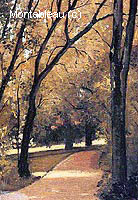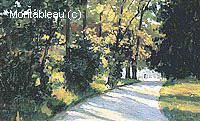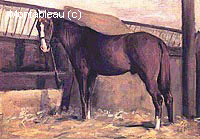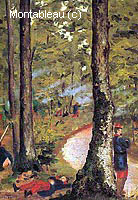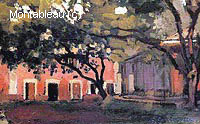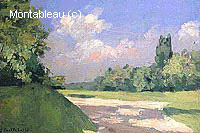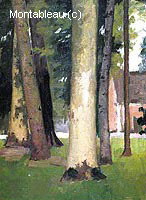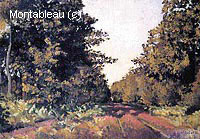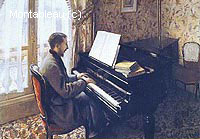
Caillebotte Gustave
by KIRK VARNEDOE, Chief Curator of Painting and Sculpture, The Museum of Modern Art, New York "Despite the rhetoric of its early advocates, the success of Impressionism did not arrive by destiny. It required, beyond the achievements on the canvases and the serendipity of circumstance, hard work on the part of several individuals among whom Gustave Caillebotte was one of the most dedicated. He haggled and negotiated to keep the group together through periods of fractious disagreement; and when he had to, he rented the exhibition space, paid for the advertising, bought frames, and hung the pictures. In what would now be called the management and marketing aspects of Impressionism, he was an indispensable asset. "Caillebotte further fueled the movement by buying paintings from his needy colleagues. Yet more than just a source of charity, he was also a collector with uncannily astute judgment. Several of the impressionist artists were his close friends, and their "moment" shaped his taste definitively: he never acquired works by Georges Seurat or Paul Gauguin, for example, or any other Symbolist or Post Impressionist artist (with the obvious exception of Cézanne), despite ample opportunity. Nor did he ever buy canvases from friends and contemporaries of lesser talent, such as De Nittis or Beraud or Guillaumin. Personal connections helped form, but never deformed, Caillebotte's remarkable eye for quality. By that acumen and by his farsighted bequest of his collection to France under conditions that ensured it would be taken seriously, he again affirmed himself as central to Impressionism's achievements. "Caillebotte's own art is, however, the more problematic part of his role in history. His career was uneven and relatively brief. It yielded a range of fully competent landscapes and portraits, occasionally inspired still lifes, a notable and sometimes idiosyncratic vein of indoor and outdoor domestic genre scenes, and, above all, a striking, singularly poetic series of images of urban life. His treatment of the society and settings of his day has often led him to be compared with Realist writers such as Duranty, Huysmans, and Zola; but actually Caillebotte has, at his best, a very different kind of force, by virtue precisely of the unnovelistic spareness of structure and lack of extraneous incident in his scenes. The dozen or so indelibly memorable images he created between 1875 and 1882 seem more to foretell the devices of later cinema; and in these important respects as regards their construction of space, distinctive viewpoints, and assertive compositional architecture they rival or outstrip the art of his more illustrious colleagues in inventiveness. "it is unavoidable, even if awkward and ultimately less than informative, to broach the general question as to whether Caillebotte was "as good as" the other Impressionist painters. Without belaboring the obvious caveats about relative criteria of "good," a short and simplified answer would have to be "no." He had neither Edgar Degas's skills as a draftsman nor Monet's as a colorist, and his development was not as extensive as those of his fellows. Yet comparing picture for picture - and speaking both as a historian of modern art and on more purely subjective aesthetic grounds I would value any one of Caillebotte's best works (e.g., Floor Scrapers, Young Man at His Window, Boulevard Seen from Above, and especially the monumental Pont de l'Europe and Paris Street: Rainy Day as a more important, original, and rewarding painting than any Pissarro, all but a handful of Renoirs, and a fair number of Monets from the same period. In these particular pictures, and with all the familiar qualifications that should surround such a judgment, Caillebotte's achievement as an artist is at least as complex and enduringly interesting as that of his peers. This cannot be anything other than a personal assessment, but I suspect that I am far from alone in making it. Each of these paintings has a singularity that does not characterize, say, Monet's various views of Argenteuil, or Pissarro's suburban scenes, or Renoir's nudes. Yet beyond stylistic similarities, these pictures and others close to them (e.g., Luncheon, A Traffic Island, Boulevard Haussmann also share a psychological or emotive "family resemblance" embodying a specific artistic personality that is distinct from that of any of Caillebotte's contemporaries, and dim or absent in the rest of his own work. We could well imagine that several painters of the day might have created The Place Saint Augustin of 1877/78 or the Sailboats in Argenteuil of c. 1888; however pleasing they may be, they convey little of the originality and pose us few of the challenges of the major early canvases. The intriguing circumstances of Caillebotte's life as a wealthy young man in the midst of a contested avant garde struggle, and certainly his comprehension of the complexities of Paris in his day, must lie behind and bear on all the pictures he made; but without his series of ambitious early achievements, we would hardly care. It is that select cluster of images from his brief years in the public eye - the wanderers with the umbrellas, the men scraping the floorboards, the vertiginous downward stare - that makes us want to know more about their author and the stories behind them. These are also, unlike the sailboat scenes and landscapes that settle so naturally into the secondary ranks of Impressionism, pictures that aggressively "don't fit" into the traditional ways of understanding the period; and thus they have provided a stimulating irritant for the minds of art historians. "The story of these paintings is still being written...but the part that involves their neglect and recuperation - the story of the long silence that seems to have surrounded them for most of the century since Caillebotte's death, and of their eventual return to the limelight - can at least be outlined here, in terms of some particular historical and art historical circumstances. The Floor Scrapers, the Pont de 1'Europe, and Caillebotte's other principal pictures were in fact extensively discussed and debated within the immediate critical writing about the Impressionist exhibitions in which he appeared; but as he had no need to sell them, his paintings stayed largely in his hands (and eventually passed to his brother and his brother's descendents). After he stopped exhibiting at the age of thirty-four, and except for the retrospective following his death twelve years later, they were rarely seen; and without reproductions in general circulation, they were largely forgotten when histories of Impressionism were written. Caillebotte was remembered, if at all, for his bequest. "When in the 1950s the artist's descendents began to sell some of his paintings, illustrations of the work began to become available. Then art historical currents regarding later nineteenth century art shifted in a way that favored reconsideration of his art; and this started to happen, not coincidental1y, around the time in the 1960s that The Art Institute of Chicago acquired his masterpiece Paris Street; Rainy Day. (My own fascination with the artist began, for example, when Paris Street appeared on the cover of the 1969 exhibition catalogue The Past Rediscovered: French Painting 1800-1900.) The 1974-75 exhibition "The Impressionist Epoch," which commemorated the first Impressionist show, featured Caillebotte only as a bit player, with one small work; but by the time of the more in-depth consideration of Impressionism in the 1986 exhibition "The New Painting: Impressionism, 1874-1886," he was one of the stars of the show, represented by fifteen exhibited canvases and seven supplemental illustrations in the catalogue. If Caillebotte made history in the 1870s, history remade Caillebotte in the 1970s; and then as before, it was possible to see this artist as an exemplary intersection of major forces at play in the collisions between entrenched and new ideas, and in the vicissitudes of the market in the broadest sense. "When Caillebotte resurfaced in the 1970s, he seemed somewhat like a cultural coelacanth, an evolutionary misfit dredged from the depths of early modern art, whose unfamiliar hybrid features challenged existing views of the organization of the field. A basic conundrum that had already prompted critical debate when the pictures were first shown was revived in retrospective, historical terms. His paintings did not show the brightly colored fields of broken brush strokes we had been taught were the essence of Impressionism; they had on the contrary a dry, tight facture that seemed to belong more with the regressive painters of the Salon, for whom we had cultivated a derisive contempt. Yet this artist and these images of contemporary life had inhabited the center of the Impressionist movement; and, in unsettling ways, both he and they seemed very, very interesting. "Caillebotte raised two important kinds of issues. On the one hand, he provoked category questions. Seeming both Impressionist and Academic, modern and conservative, his art made those divisions look rigidly simplistic. In the 1970s, moreover, that was not accepted as just a one off oddity, like the occasional mammal that also lays eggs. Instead, it added to a mounting roster of anomalies that threatened to invalidate the whole taxonomy that had formerly ranked winners and losers in later nineteenth century art according to a narrow idea of what constituted the mainstream of twentieth century art. (This doubt about historical labels arose in a period when formalist notions of a Cubist derived "main line" of progress in modern art were also losing credibility among contemporary artists and critics, following the advent of Pop Art and Minimalism; some parallels, in fact, were drawn at the time between Caillebotte's aesthetics and those of 1970s artists who also challenged the canonical "modern" category.) "As the interest of Caillebotte's pictures seemed to be less a matter of innovative technique or form and more a matter of dramatically conceived subjects, he also raised questions of context. His detailed vistas of Third Republic Paris begged topographical identification, of the kind that led historians to reckon with the histories of iron bridges, railroad stations, new boulevards and building types, and urbanism in general; and these lines of inquiry accorded well with broader patterns of 1970s scholarship (on nineteenth century art particularly) that encouraged closer examination of the social and historical conditions surrounding the work of art. In fact, Caillebotte reemerged into art history just when a broader idea of "content" began to receive more attention than questions of style, and when the appeal of context was ascending over the rubble of discredited categories. Pictures that had been exhaustively analyzed for their intrinsic forms suddenly seemed to shine with fresh meaning when reset against the foil of extrinsic, associated images and texts. Furthermore, the notion of bypassing retrospective labels and rankings to recur to the texts and terms of the 1870s, and of seeing Impressionist art as a window onto the concerns of its own time rather than as an anticipation of ours, was an intellectual ideal that then held the prestige of an ethical crusade. By debunking a notion of art's autonomy that had been fostered by annexing paintings into transcendent categories of formalist "modernism," and insisting instead on a work's embeddedness in its immediate environment of material and social circumstances, this new historicism honored the general, appealing principle of an ecological, organic connectedness - between all aspects of a society and between art history and other disciplines. "Hostility to received ideas of what constitutes "quality" or progress" was most blatantly evident in the eagerness of 1970s curators and academicians to revive Salon lions like Jean Leon Gerome and William Bouguereau; and in the climate of the moment, the consideration of these conservative, "establishment" artists seemed paradoxically liberating and anti-authoritarian. it offered the savor of forbidden fruit, and suggested an upstart, independent minded openness to the fuller range of history's complexities. Looking seriously at artists such as Gerome - or Caillebotte - was an implicit rejection of the idea that "advanced" technique or formal properties determined an artwork's importance, and since emphasis on a picture's content, as opposed to its style, involved disrespecting specialized formalist jargon or mystifying criteria of judgment, it had an antimandarin, democratizing, or even populist edge. "In academic art history, these reconsiderations of the nineteenth century allowed for new areas of specialization in a crowded field; and the emphasis on contextual description opened up a virtually limitless terrain of material to research, footnote, and publish. (For an American academia overtenured after the expansive days of the 1960s, these considerations were not trivial.) In other markets, too, the changes brought expanded opportunities: the emergence of interest in lesser-known artists was promoted by art dealers eager to open new audiences for a broader range of items that were available and relatively cheap. Caillebotte was, in this context, ripe for investment in all the senses: relatively unstudied by academics, he also offered collectors a certifiable Impressionist - with all the trappings from top hats to sailboats and gardens - at bargain, well below Monet prices. (The value of some of Caillebotte's paintings increased by multiples of ten or more in just the last half of the 1970s.) "There was within "revisionism," then, an unlikely and largely unspoken congruence between value questioning scholarly revisions and value creating commercial interests. Similarly, those who were apparently united in opposition to outdated definitions of modernism, and hence, of Impressionism, were often actually deeply opposed to one another. Some of the most doctrinaire of the "democratizing" leftist revisionists were staunchly elitist in their contempt for the revival of Salon painters, and in their insistence on the primacy of "difficult" avant garde work; while those who sought to redefine the modern tradition found themselves attacked by colleagues who wanted only to certify its death and get on with a Postmodernist writing of history. Yet Caillebotte's revival was one of several phenomena that were propelled to varying degrees by all these waves and fashions together, in ways that did not appear so evidently paradoxical at the time. If Caillebotte was by birth a child of 1848, he was by this rebirth an offspring of 1968, and of the contradictory climate of intellectual upheaval that had followed on that pivotal political year. "Since then, of course, the art market has changed, and so has the market of ideas in art history. The revisionists of the 1970s produced students who are now tenured and are themselves producing the next wave of young scholars, a generation born well after 1968 which will enter a sharply altered field of nineteenth century studies. And in 1994, oddly enough, that field seems - in ways that will doubtless affect fresh reconsiderations of Impressionism and of Caillebotte - to have turned a circle toward a new reign of categories and hierarchies. "Modernism" is perhaps the prime example. Following its widely reported death, this abstract category now seems more indispensable as an intellectual shibboleth more reified, more believed in, and more deforming than it ever was in its ostensible prime. No longer seen just as a formalist aesthetic fiction to be debunked, the notion of a "logic of modernism" or a "modernist project" is now ritually invoked as a formidably real and all pervasive historical force shaping thought and social relations. In recent views of the art of the past century and a half, artists and images are once again being extricated from their local circumstances and inserted (now in condemnation rather than praise) into larger stories of the progress of "modernism" - as they are also being set into parallel stories of the body, the gaze, and the spectacle. Along the way, formerly specific descriptive terms such as "space" or "site" have also metamorphosed into disembodied, metaphoric frames of psychological or sociological reference. As ways of explaining and giving meaning to the art of the past, such global categories of current understanding are today embraced with fresh conviction as subsuming and transcending the contingencies of immediate historical conditions. "Context, meanwhile, has become hypostatized as a focus of concern, with the "foregrounding" of what used to be thought of as background. The examination of what is not in a given work of art has proven to be an appealingly unconstrained and open ended endeavor, and the task of providing a convincing connection between this associated material and the work of art itself has come to seem secondary or irrelevant to many practitioners of a new anthropolopy of images. A study that might formerly have embedded a Manet nude within a web of popular erotic imagery would now more likely go straight at pornography as more representative of broader currents. This more drastic leveling of visual representations, while self professedly political, has nonetheless shed any of the former taint of populism. It is more typically associated with the resurgent prestige of specialized jargons about large theoretical concepts, and thus with a freshly defiant vision of art history as a mandarin enterprise of rarefied knowledge, by some occult balance, as the material observed becomes more demotic, the ideas applied often become more steeply clubbish. "If a "new Caillebotte" is shaped from within these parameters, he will surely be less of a misfit; his art will be seen less as an anomaly and more as a legible, even paradigmatic, expression of decodable historical circumstances and categories. His distinctive vision may, for example, be more solidly assimilated to something called modernism, though this will likely not be to his credit as a progressive force of liberation; he is more probably ripe for portrayal as a representative of modernism's ostensibly intrinsic discontents - for example, his pictures embodying (in the authority of their perspectives) the oppressively rationalizing, dominant optic of the leisured and empowered urban male; or his peculiar compositions revealing (in their tensions) the intrinsic contradictions of conflicted social spaces in maturing capitalism. Along the way, we will certainly learn much more about the particulars of the artist's family, his relationships, and the contexts of his life, both immediate and general, but to the extent that those dozen or so remarkable images come to be comfortably understandable in terms of these encapsulations, there will inevitably be some risks with the gains. Categories and contexts help us to see Caillebotte's images as examples of, or windows onto, other phenomena; yet the more successful that process is, the more it may tend to efface rather than illuminate the individuality of his art. "Categories are, after all, only abstractions we use as shorthands to deal with accumulated contingencies, we misuse them when we imply that they generate these contingencies, or determine a particular individual or act. Individuals make up these categories, but these categories do not make up individuals. This is just as true for "modernist" as a broad sociological term as it was for "modernist" as a narrow formalist term; and whether it is "Impressionist" or "wealthy Third Republic male," the issue was not and is not how such labels define Caillebotte, but how he redefines them. Contextual examination has its own parallel pitfall: each background that is used to explain an event or object, in turn itself begs interpretation within some broader context, and so on into infinitely expanding circles with steadily decreasing relevance to the subject at hand. (The ultimate extension of this holistic idea, to paraphrase Bertrand Russell, is the premise that we cannot talk about any one thing unless we talk about everything.) Yet an artwork that arises from within countless overlapping contexts is not finally determined by any; it has a specificity that emerges from the unique convergence of many in its creation, and then expands in meaning through still others it subsequently traverses - as even our schematic sketch of Caillebotte's recent critical fortunes already suggests. "With determinist ideas of context, as with essentialist notions of categories, our constant temptation is to invert the order of things, and reckon that individualities like Caillebotte's become meaningful when they are seen to reveal and conform to larger, more basic and potent elements of history - to "isms," or movements, or unfolding struggles between vast social forces. Yet from the unpredictable variations that drive Darwinian evolution upward through every level of human chronicle, individualities and unique contingencies are not secondary epiphenomena of history, but rather its basic motor. This is nowhere more evident than in works of art, which endure to the degree that they do not fit exactly, but supersede the niches in which they were created and each of the shifting labels imposed on them. A quirky, uncontrollable specificity lies both at the root of history (or nature) and at its crown; it is both the spark of events and, through art and interpretation, their afterglow. "This is one of the reasons Caillebotte's "misfit" nature has been so instructive. In their episodic, interrupted eccentricity, Caillebotte's historiographic fortunes also point out with particular clarity some elementary lessons about both art history's limitations and its open-endedness. Since the artist is dead, no amount of documentation will ever recapture a complete reckoning with his view of the world, or understanding of him as an individual. We can compile in denser and finer grained detail analytic accounts of the things he shared with others, from the available conventions of perspective to the character of his arrondissement; but the very things that we sense are critical to the impact of the most personal pictures - the motivations for the choice and framing of subject, the decisions as to what to put in and what to leave out, and so on - are the contingent elements of his private individuality on which we can only speculate without hope of confirmation. And, since the art endures, that speculation can never pretend to finality. "In the face of these humbling limitations, historians can be seduced by twin forms of hubris. Reading Caillebotte's mind through his art, we may imply that we see as clearly as he the larger issues and dilemmas he faced, or even that in our retrospect we know more about his situation than he did. Such presumptions entail a denial of the real weight of history's mortal finalities, and a false arrogance toward our predecessors. The matching delusion, which allows us to believe our accounts of his pictures can be definitive, is equally arrogant toward those who will supplant us, see around our blinders, and add something new to the process. "Those of us who had the chance to try to contribute something to the understanding of Caillebotte in the 1970s, and who hold the happy memory of having "known" him and these images when they seemed more unknown, wait attentively now to discover him and them anew in the work of others. Each individual, inevitably subjective viewpoint asks questions and proposes insights that leave behind a residue of data and judgments to be corrected, rejected, or amended as time and viewers change. The resulting field of dispute is the only terrain for consensus a plural society can have about its culture. As we have seen, the contingencies of history have, for a great variety of often contradictory reasons, accorded Caillebotte's pictures shifting values in several senses. This process, ongoing and unpredictable, accords the works an "autonomy" that, far from being a denial of history, is intrinsic to its processes. The complexly layered, emergent specificity that results is as close as we can get to an analogue for the intricate uniqueness of the personality that made the pictures originally and that, in elusive residue, makes them compelling still; it is one of history's substitutes for the irretrievable, as cultural innovation and continuity are consolations for human loss."
See more
